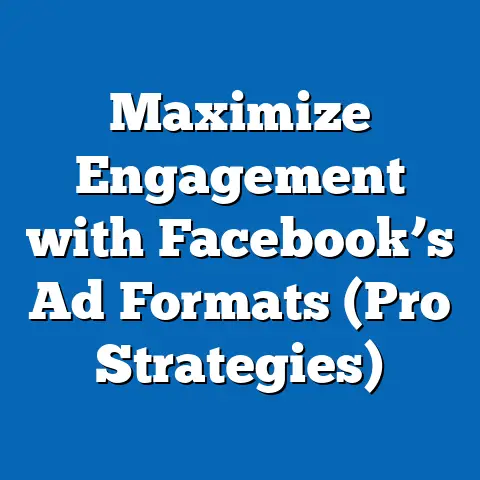Unlocking ThruPlay in Facebook Ads (Powerful Insights)
I’ve seen it countless times. Businesses pour money into Facebook ads, focusing on vanity metrics like impressions and clicks, only to be disappointed with the results. They’re essentially shouting into a crowded room, hoping someone will hear them, without really considering if anyone’s actually listening. This is a common mistake, and it stems from a misunderstanding of what truly drives results in the world of video advertising: engagement.
That’s where ThruPlay comes in. Forget simply getting your ad seen; ThruPlay is about getting it watched. It’s a metric that cuts through the noise and tells you who’s genuinely interested in what you have to say. In this article, I’m going to delve deep into the world of ThruPlay, explaining why it’s essential, how to leverage it, and how it can transform your Facebook advertising strategy from a gamble into a data-driven success.
Section 1: Understanding ThruPlay
Definition of ThruPlay
So, what exactly is ThruPlay? It’s a Facebook Ads metric that counts the number of times your video ad is played to completion, or for at least 15 seconds. Think of it as a “qualified view.” It’s not enough for someone to simply scroll past your ad; they have to actively engage with it for a significant amount of time.
Facebook introduced ThruPlay to address a growing concern among advertisers: the disconnect between impressions and actual engagement. Before ThruPlay, it was difficult to gauge whether people were genuinely watching video ads or simply scrolling past them. This metric provided a more accurate picture of viewer attention, empowering advertisers to optimize their campaigns for meaningful engagement.
The Value Proposition of ThruPlay
Why is ThruPlay so valuable? Because it’s a strong indicator of customer intent, engagement, and potential conversion rates. Someone who watches your entire video, or at least 15 seconds of it, is far more likely to be interested in your product or service than someone who only sees your ad for a fraction of a second.
In my experience, focusing on ThruPlay views leads to:
- Higher Quality Leads: Viewers who watch your entire video are more informed and qualified, making them better prospects.
- Improved Brand Recall: A longer viewing time increases brand recognition and memorability.
- Better Return on Ad Spend (ROAS): By targeting viewers who are genuinely interested, you reduce wasted ad spend and improve your overall ROAS.
- Deeper Understanding of Your Audience: Analyzing ThruPlay data helps you understand what resonates with your audience, allowing you to create more effective video content.
Think of it like this: imagine you’re giving a presentation. Would you rather present to a room full of people who are half-asleep and distracted, or a room full of engaged listeners who are actively paying attention? ThruPlay helps you find that room full of engaged listeners.
Key Takeaway: ThruPlay is a crucial metric for understanding the true engagement of your video ads and optimizing your campaigns for better results.
Section 2: Setting Up for Success
Creating Compelling Video Content
You can’t expect to achieve high ThruPlay rates with boring, uninspired video content. To maximize ThruPlay, you need to create videos that capture attention, hold interest, and leave a lasting impression. Here are some elements of a successful video ad:
- Hook Them Early: The first few seconds are critical. Use a captivating visual, a compelling question, or a surprising statement to grab viewers’ attention immediately.
- Tell a Story: People connect with stories. Use storytelling to convey your message in a memorable and engaging way.
- Keep it Concise: Respect your viewers’ time. Get to the point quickly and avoid unnecessary fluff. Aim for videos that are between 15 and 60 seconds long.
- Use High-Quality Visuals: Invest in professional-quality video production. The visuals should be clear, engaging, and visually appealing.
- Include a Clear Call to Action (CTA): Tell viewers what you want them to do next. Whether it’s visiting your website, making a purchase, or signing up for a newsletter, make it clear and easy for them to take action.
- Optimize for Mobile: Most Facebook users are on mobile devices. Make sure your video is optimized for mobile viewing, with clear text and visuals that are easy to see on smaller screens.
- Add Captions: Many people watch videos with the sound off. Adding captions ensures that your message is still conveyed, even without audio.
I once worked with a client who was struggling with their video ad performance. Their videos were visually appealing, but they weren’t getting many ThruPlay views. After analyzing their content, we realized that their videos lacked a clear narrative and didn’t immediately grab viewers’ attention. We revamped their videos to include a compelling story and a strong hook in the first few seconds. The result? Their ThruPlay rates skyrocketed, and their overall campaign performance improved significantly.
Targeting the Right Audience
Even the most compelling video content will fail if it’s shown to the wrong audience. Audience targeting on Facebook plays a crucial role in determining your ThruPlay metrics. By targeting the right audience, you increase the likelihood that people will be interested in your video and watch it to completion.
Here’s how to refine your targeting strategies for video ads:
- Use Facebook’s Audience Insights: This tool provides valuable data about your target audience, including their demographics, interests, behaviors, and more. Use this information to create more targeted ad campaigns.
- Create Custom Audiences: Upload your existing customer list or website traffic to create custom audiences. These are people who are already familiar with your brand and are more likely to be interested in your video.
- Use Lookalike Audiences: Create lookalike audiences based on your existing customers or website visitors. These are people who share similar characteristics with your target audience and are likely to be interested in your video.
- Experiment with Different Targeting Options: Don’t be afraid to experiment with different targeting options to see what works best. Test different demographics, interests, and behaviors to find the audience that is most receptive to your video.
- Monitor Your Results: Keep a close eye on your ThruPlay metrics and adjust your targeting strategies accordingly. If you’re not seeing the results you want, try targeting a different audience.
I remember working on a campaign for a local restaurant. We initially targeted a broad audience, but our ThruPlay rates were low. After analyzing our data, we realized that our video was resonating more with people who were interested in food and dining. We refined our targeting to focus on this audience, and our ThruPlay rates increased dramatically.
Key Takeaway: Compelling video content and targeted audience selection are essential for maximizing ThruPlay rates.
Section 3: Analyzing ThruPlay Metrics
Understanding ThruPlay Insights
ThruPlay isn’t just a standalone metric; it’s part of a larger ecosystem of video ad analytics that can provide valuable insights into your campaign performance. By diving deeper into the analytics provided with ThruPlay, you can gain actionable insights that will help you optimize your video ads for better results.
Here are some key metrics to pay attention to:
- Cost per ThruPlay: This metric tells you how much you’re paying for each ThruPlay view. A lower cost per ThruPlay indicates that your video is resonating well with your target audience and that your targeting is effective.
- Video Completion Rate: This metric tells you the percentage of people who watched your video to completion. A higher video completion rate indicates that your video is engaging and holding viewers’ attention.
- Engagement Rate: This metric measures the level of interaction with your video, including likes, comments, shares, and saves. A higher engagement rate indicates that your video is resonating with your audience and that they are actively engaging with your content.
- Audience Retention: This metric shows you how long people are watching your video. By analyzing the audience retention graph, you can identify the points in your video where people are dropping off. This information can help you improve your video content and keep viewers engaged for longer.
- Demographics and Interests: Facebook provides data about the demographics and interests of the people who are watching your video. This information can help you refine your targeting strategies and create more relevant video content.
To truly understand these metrics, you need to actively monitor them within Facebook Ads Manager. I recommend setting up custom columns that display the metrics you’re most interested in. This will allow you to quickly and easily track your video ad performance.
Comparing ThruPlay to Other Metrics
While ThruPlay is a valuable metric, it’s important to understand its limitations and how it compares to other metrics like reach and impressions. Relying solely on clicks and impressions can be misleading, as they don’t necessarily indicate genuine engagement or interest.
Here’s a comparison of ThruPlay with other common metrics:
- Reach: Reach measures the number of unique people who saw your ad. While reach is important for brand awareness, it doesn’t tell you anything about whether people actually watched your video.
- Impressions: Impressions measure the number of times your ad was displayed. Like reach, impressions don’t necessarily indicate engagement.
- Clicks: Clicks measure the number of times people clicked on your ad. While clicks are a good indicator of interest, they don’t tell you whether people watched your video before clicking.
- ThruPlay: ThruPlay measures the number of times your video was played to completion (or for at least 15 seconds). This is a more accurate indicator of engagement and interest than reach, impressions, or clicks.
In my experience, focusing solely on reach and impressions can lead to wasted ad spend. You might be reaching a large number of people, but if they’re not actually watching your video, you’re not getting any value from your advertising. ThruPlay provides a more comprehensive view of ad performance by measuring genuine engagement.
For example, I had a client who was focused on maximizing their reach. They were spending a lot of money on Facebook ads, but their sales weren’t increasing. After analyzing their data, we realized that their ThruPlay rates were very low. People were seeing their ads, but they weren’t actually watching them. We shifted our focus to creating more engaging video content and targeting a more relevant audience. As a result, their ThruPlay rates increased, and their sales started to climb.
Key Takeaway: ThruPlay provides a more accurate and comprehensive view of ad performance than traditional metrics like reach, impressions, and clicks.
Section 4: Leveraging ThruPlay for Campaign Optimization
Ad Placement Strategies
Where you place your video ad on Facebook can have a significant impact on your ThruPlay rates. Different ad placements, such as Feed, Stories, and In-Stream, cater to different user behaviors and content consumption patterns.
Here’s how different ad placements can impact ThruPlay rates:
- Feed: The Facebook Feed is the primary destination for users to scroll through content from friends, family, and businesses. Feed ads are typically longer and more informative, allowing you to tell a more complete story.
- ThruPlay Potential: High, if your video is engaging and relevant to the user’s interests.
- Content Strategy: Focus on storytelling, providing value, and capturing attention within the first few seconds.
- Stories: Facebook Stories are short, ephemeral videos and images that disappear after 24 hours. Stories ads are typically shorter and more visually engaging, designed to capture attention quickly.
- ThruPlay Potential: Moderate, as users tend to swipe through Stories quickly.
- Content Strategy: Keep it short, visually appealing, and use strong calls to action.
- In-Stream: In-Stream ads are short videos that play before, during, or after other videos on Facebook. In-Stream ads are typically shorter and more targeted, designed to reach users who are already engaged with video content.
- ThruPlay Potential: High, as users are already in a video-watching mindset.
- Content Strategy: Create highly engaging and relevant videos that capture attention quickly and provide value.
- ThruPlay Potential: High, if your video is engaging and relevant to the user’s interests.
- Content Strategy: Focus on storytelling, providing value, and capturing attention within the first few seconds.
- ThruPlay Potential: Moderate, as users tend to swipe through Stories quickly.
- Content Strategy: Keep it short, visually appealing, and use strong calls to action.
- ThruPlay Potential: High, as users are already in a video-watching mindset.
- Content Strategy: Create highly engaging and relevant videos that capture attention quickly and provide value.
To maximize ThruPlay rates, it’s essential to tailor your content for each placement. For example, a longer, more informative video might work well in the Feed, while a shorter, more visually engaging video might be better suited for Stories.
I learned this lesson the hard way when I first started experimenting with Facebook video ads. I created the same video for all placements, without considering the unique characteristics of each platform. My ThruPlay rates were disappointing. After researching best practices, I realized that I needed to create different videos for different placements. I started tailoring my content for each platform, and my ThruPlay rates improved significantly.
Retargeting and Lookalike Audiences
ThruPlay data can be a goldmine for retargeting and creating lookalike audiences. By retargeting users who completed your video ads, you can reach people who are already interested in your product or service. By creating lookalike audiences based on users who completed your video ads, you can reach new people who are likely to be interested in your product or service.
Here’s how to effectively use ThruPlay data for retargeting strategies:
- Create a Custom Audience of Video Viewers: In Facebook Ads Manager, create a custom audience of people who watched your video to completion (or for at least a certain percentage of the video).
- Retarget This Audience with a Special Offer: Retarget this audience with a special offer, such as a discount code or a free trial.
- Personalize Your Retargeting Ads: Personalize your retargeting ads based on the content of the video they watched. For example, if they watched a video about a specific product, retarget them with ads for that product.
Here’s how to create lookalike audiences based on users who completed your video ads:
- Create a Custom Audience of Video Viewers: In Facebook Ads Manager, create a custom audience of people who watched your video to completion (or for at least a certain percentage of the video).
- Create a Lookalike Audience Based on This Custom Audience: In Facebook Ads Manager, create a lookalike audience based on this custom audience.
- Target This Lookalike Audience with Your Video Ads: Target this lookalike audience with your video ads.
I’ve seen firsthand how effective retargeting and lookalike audiences can be for improving ThruPlay rates and driving conversions. By targeting people who are already interested in your product or service, you increase the likelihood that they will watch your video and take action.
Key Takeaway: Leveraging ThruPlay data for retargeting and lookalike audiences can significantly improve your campaign performance.
Section 5: Case Studies and Real-World Applications
Successful Campaigns Using ThruPlay
Let’s take a look at some real-world examples of brands that have successfully integrated ThruPlay into their Facebook ad strategies.
- Example 1: A Clothing Retailer: This retailer created a series of video ads showcasing their new clothing line. They targeted a specific demographic with interests in fashion and style. By focusing on ThruPlay, they were able to identify the videos that resonated most with their target audience. They then used this information to optimize their ad spend and improve their overall campaign performance. They saw a 30% increase in website traffic and a 20% increase in sales.
- Example 2: A Software Company: This company created a video ad explaining the benefits of their software. They targeted a specific industry with interests in technology and business. By focusing on ThruPlay, they were able to identify the viewers who were most engaged with their video. They then retargeted these viewers with a special offer for a free trial. They saw a 40% increase in free trial sign-ups and a 15% increase in paying customers.
- Example 3: A Local Restaurant: This restaurant created a video ad showcasing their delicious food and inviting atmosphere. They targeted a specific geographic area with interests in food and dining. By focusing on ThruPlay, they were able to identify the viewers who were most likely to visit their restaurant. They then retargeted these viewers with a special offer for a discount on their next meal. They saw a 25% increase in foot traffic and a 10% increase in sales.
These case studies demonstrate the power of ThruPlay as a metric for optimizing Facebook ad campaigns. By focusing on ThruPlay, these brands were able to identify the videos that resonated most with their target audience, retarget engaged viewers, and drive conversions.
Common Challenges and Solutions
While ThruPlay can be a powerful tool, it’s not without its challenges. Here are some common challenges advertisers face when trying to optimize for ThruPlay:
- Low ThruPlay Rates: If your ThruPlay rates are low, it could be due to a number of factors, such as unengaging video content, poor targeting, or ineffective ad placement.
- Solution: Review your video content, targeting strategies, and ad placements. Make sure your video is captivating, your targeting is accurate, and your ad placement is appropriate for your content.
- High Cost per ThruPlay: If your cost per ThruPlay is high, it could be due to inefficient targeting or a lack of competition.
- Solution: Refine your targeting strategies to reach a more relevant audience. Experiment with different bidding strategies to see what works best.
- Difficulty Retargeting: If you’re having trouble retargeting viewers who completed your video ads, it could be due to privacy settings or a lack of data.
- Solution: Make sure your privacy settings are configured correctly. Use Facebook’s pixel to track website visitors and create custom audiences.
- Solution: Review your video content, targeting strategies, and ad placements. Make sure your video is captivating, your targeting is accurate, and your ad placement is appropriate for your content.
- Solution: Refine your targeting strategies to reach a more relevant audience. Experiment with different bidding strategies to see what works best.
- Solution: Make sure your privacy settings are configured correctly. Use Facebook’s pixel to track website visitors and create custom audiences.
I’ve encountered these challenges myself, and I’ve learned that the key to overcoming them is to be persistent and data-driven. Continuously monitor your metrics, experiment with different strategies, and adjust your approach based on the results.
Key Takeaway: Understanding common challenges and implementing effective solutions is crucial for maximizing the benefits of ThruPlay.
Section 6: The Future of Video Advertising on Facebook
Trends in Video Content
The world of video advertising is constantly evolving, and it’s important to stay up-to-date on the latest trends and best practices. Here are some upcoming trends in video advertising on social media platforms, particularly Facebook:
- Short-Form Video: Short-form video content, such as TikTok videos and Instagram Reels, is becoming increasingly popular. Facebook is also investing heavily in short-form video, so expect to see more opportunities to create and share short videos on the platform.
- Interactive Video: Interactive video allows viewers to engage with the content in a more meaningful way. This can include quizzes, polls, clickable hotspots, and more. Interactive video is a great way to increase engagement and drive conversions.
- Personalized Video: Personalized video allows you to tailor your video content to individual viewers. This can include using their name, location, or other personal information. Personalized video is a great way to capture attention and build relationships.
- Live Video: Live video allows you to connect with your audience in real-time. This can include Q&A sessions, product demonstrations, and behind-the-scenes glimpses. Live video is a great way to build trust and create a sense of community.
As these trends continue to evolve, ThruPlay will likely adapt as a metric. We can expect to see Facebook introduce new features and tools that make it easier to track and optimize video ad performance.
Integrating ThruPlay with Broader Marketing Strategies
ThruPlay isn’t just a metric for Facebook advertising; it’s a valuable data point that can inform your broader marketing strategies. By integrating ThruPlay insights with your email marketing, social media, and SEO efforts, you can create a seamless customer journey that leverages video content effectively.
Here’s how to integrate ThruPlay with your broader marketing strategies:
- Email Marketing: Use ThruPlay data to segment your email list and send more targeted emails. For example, you could send a special offer to people who watched your video about a specific product.
- Social Media: Use ThruPlay data to inform your social media content strategy. Create more content that resonates with your audience based on the videos they watched.
- SEO: Use ThruPlay data to identify keywords and topics that are relevant to your audience. Use these keywords and topics to optimize your website and blog content.
Creating a seamless customer journey that leverages video content effectively requires a holistic approach. By integrating ThruPlay insights with your broader marketing strategies, you can create a more engaging and effective experience for your customers.
Key Takeaway: ThruPlay is a valuable data point that can inform your broader marketing strategies and create a seamless customer journey.
Conclusion
Summarize the Key Points
In this article, I’ve explored the importance of focusing on ThruPlay as a metric for video ad success. I’ve explained what ThruPlay is, why it’s valuable, how to leverage it, and how it can transform your Facebook advertising strategy.
Here are the key takeaways:
- ThruPlay is a crucial metric for understanding the true engagement of your video ads.
- Compelling video content and targeted audience selection are essential for maximizing ThruPlay rates.
- Analyzing ThruPlay metrics provides valuable insights into your campaign performance.
- Leveraging ThruPlay data for retargeting and lookalike audiences can significantly improve your campaign performance.
- Understanding common challenges and implementing effective solutions is crucial for maximizing the benefits of ThruPlay.
- ThruPlay is a valuable data point that can inform your broader marketing strategies and create a seamless customer journey.
Call to Action
Now that you have a better understanding of ThruPlay, I encourage you to reflect on your current Facebook ad strategies and consider how you can integrate ThruPlay insights to enhance your campaign effectiveness. Start by analyzing your existing video ads and identifying areas for improvement. Experiment with different targeting strategies and ad placements. Continuously monitor your metrics and adjust your approach based on the results.
By focusing on ThruPlay, you can create more engaging and effective video ads that drive results for your business. So, go ahead and unlock the power of ThruPlay! You might be surprised at the difference it makes.






